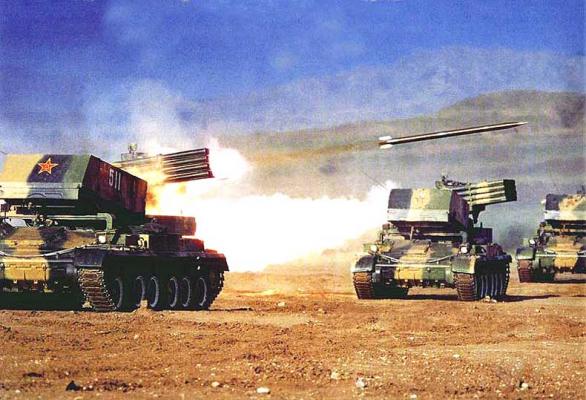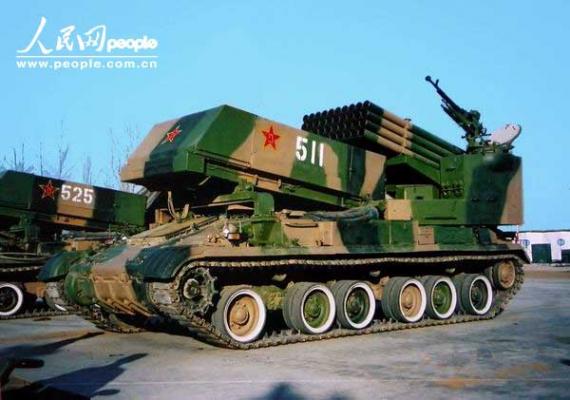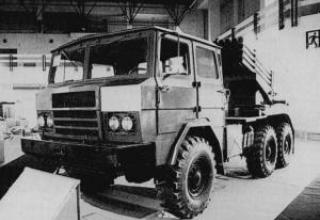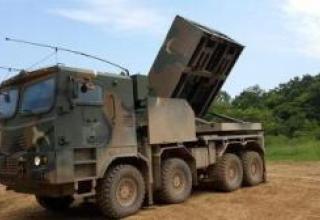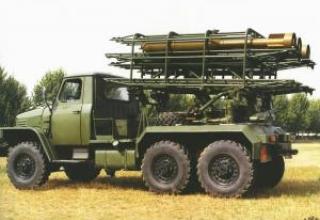The development of a 122mm multiple launch rocket system began in China after the Soviet-Chinese armed conflict on Damansky Island. The combat use by the Soviet troops of the BM-21 "Grad" MLRS during this conflict made a strong impression on the command of the People's Liberation Army of China (PLA).
In 1979, during the Sino-Vietnamese border conflict, several BM-21 systems were captured by Chinese troops, and they served as the basis for the first Chinese 122-mm MLRS - "Type-81", which was tested in 1980. In 1983, this system was launched into mass production and began its delivery to the PLA reactive artillery divisions. Over the years, the system was repeatedly upgraded to improve combat efficiency, range and accuracy. As a result, the range of fire of unguided rockets (NURS) was increased from 20 km to 40 km, the range of used combat units was significantly expanded, and an automated fire control and charging system was introduced.
Later versions of the 122-mm MLRS are the variants of placing this system on the armored tracked chassis "Type-321". (designated "Type 89") and on the chassis of the off-road truck "Tiema" SC2030 ("Type-90"). The "Type-90" is produced since the mid-1990s, has a modern, improved automated fire control system, is equipped with "Type-704" radar and is actively offered by developers on the international arms market.
Composition:
Type 89" is a part of the RESO:
- combat vehicle (photo_1,photo_2),
- NURS,
- fire control system,
- promoter charging device
- transport-charging machine.
Shots are fired by 122 mm unguided rockets, stabilized in flight by opening four-blade stabilizers (see photo). A shrapnel-type, high-explosive warhead is considered the main head of the projectiles, but there is also a high-explosive shrapnel-type warhead (containing 4,100 steel balls) as well as a cluster head. A cassette BC may be equipped with 39, 44 or 74 fragmentation-cumulative warheads, 6 anti-tank mines or 128 anti-personnel mines. There is also an incendiary head unit with 6,000 incendiary elements scattered within a radius of 30m.
The fire control system enables single and multiple firing. The duration of the salvo is 20 seconds.
Charging of the launcher is carried out using a special device mounted in the front of the tracked chassis. It is a rack with 40 rockets on it. Before charging, the guide pack and the projectile rack are moved to the charging position, after which all 40 projectiles are hydraulically moved into the guides. This reduces the charging time of the starter unit to two minutes. Manual charging of the launcher by means of a transport and charging machine is also possible.
Launching unit RSZO "Type 89" is designed on the basis of a unified tracked chassis "Type-321". As with the base machine, the control room is located in the front of the hull at the left side. To the right of it there is a motor-transmission compartment. On the armored plate, which covers both compartments from above, is mounted a device for mechanized recharging of the launcher. The artillery part, as well as the majority of RSZO launchers, is located in the aft part of the hull on the roof of the armored deckhouse, where the fire control system equipment is located. On the march in this deckhouse there is also a four-person MLRS unit.
The armored hull of the launcher is welded from 10 mm thick rolled armored plates and protects the calculation from small arms bullets and fragments of artillery shells and mines. The artillery unit is mounted on a swivel base and consists of a package of 40 tubular guides (four rows of guides with 10 pipes each). Lifting and swiveling mechanisms mounted on the swivel base allow to point the artillery unit in the vertical plane in the range of angles from 0° to +55°. The angle of horizontal firing is 168°. The pointing mechanisms are equipped with power drives, but the pointing can also be done manually.
Twelve-cylinder diesel engine 12150L installed in the engine and transmission compartment, develops a maximum power of 520 hp. The tracked chassis is equipped with six support rollers and three support rollers per side. Suspension of support rollers - individual torsion. The drive wheels are located in front. The maximum speed, which develops a self-propelled launcher on the highway, is 55 km / h. On rough terrain it overcomes steep rises up to 30°, walls 0.7m high and ditches 2.7m wide.
The launcher is equipped with a radio station, tank intercom, firefighting equipment and an infrared night vision device.
Characteristics:
| Caliber, mm | 122 |
| Weight NURS, kg | 58-68 |
| Number of guides | 40 |
| Calculation, man. | 5 |
| Weight of launcher in combat position, t | 29.9 |
| Dimensions of the launcher in camping position, m | 7.180 x 3.150 x 3.180 |
| The duration of the volley is full ammunition, s | 20 |
| Recharging time, min | 3 |
| Engine power, hp. | 520 |
| Maximum speed, km/h | 55 |
| Power reserve, km | 450 |
| BC type | Length, m | Weight,kg | Weight BC,kg | Maximum range,km |
Minimum range,km |
| FSBS | 2870 | 67 | 18.3 | 20000 | 9600 |
| FFBE with enhanced shrapnel effect | 2870 | 67 | 18.3 | 20000 | 9600 |
| FFBE with enhanced shrapnel effect | 2870 | 67 | 18.3 | 20000 | 12000 |
| Cassette BC (39 submunitions) | 3037 | 66 | 18.3 | 20000 | 9600 |
| Cassette BC (74 submunitions) | 2870 | 68 | 28 | 26000 | 13000 |
| FSBS | 2757 | 61 | 18.3 | 33000 | 12700 |
| FFBE with enhanced shrapnel effect | 2757 | 61 | 18.3 | 33000 | 12400 |
| Cassette BC (39 submunitions) | 2927 | 61 | 18.3 | 32000 | 15000 |
| FFBE with enhanced shrapnel effect | 2900 | 67 | 22 | 40000 | 20000 |
| Cassette BC (44 submunitions) | 3008 | 67 | 22 | 40000 | 20000 |
| Cassette BC (6 anti-tank min.) | 2950 | 58 | 26 | 15000 | 6000 |
Sources:
- Chinese Defence Today :: 122 mm Multiple Rocket Launcher
- Шунков В.Н. "Ракетное оружие" .-Мн.: ООО "Попурри", 2001- 528с.
